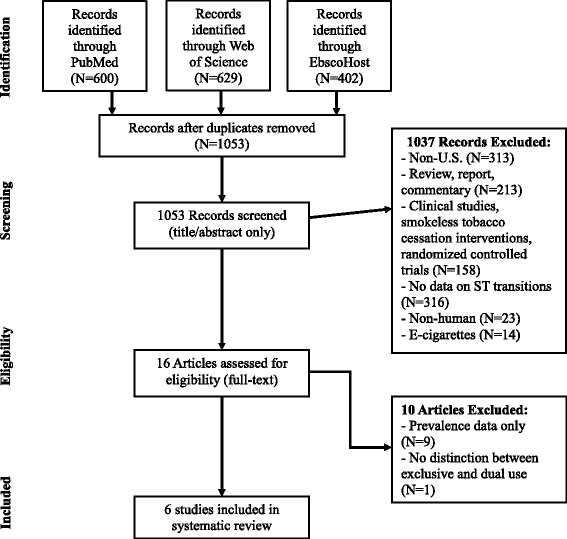A systematic review of transitions between cigarette and smokeless tobacco product use in the United States
- PMID: 25849604
- PMCID: PMC4377056
- DOI: 10.1186/s12889-015-1594-8
A systematic review of transitions between cigarette and smokeless tobacco product use in the United States
Abstract
Background: Smokeless tobacco use is becoming an increasingly important public health issue in the US and may influence cigarette smoking behavior. Systematic information on transitions between smokeless tobacco and cigarette use in the US is limited.
Methods: We conducted a systematic review of published literature on transitions between smokeless tobacco and cigarette use in the US. We searched PubMed, Web of Science and EbscoHost databases for all published articles from January 2000 to March 2014 that presented estimates of transitions in US youth and adult study populations over time between at least one of the following tobacco use states: exclusive cigarette smoking, exclusive smokeless tobacco use, dual use of both products, and use of neither product. We excluded non-English language studies, studies published before 2000, clinical trials, controlled cessation programs, and clinical studies or evaluations of smokeless tobacco cessation programs.
Results: The review identified six studies on US populations published since 2000 with longitudinal data on some or all of the transitions that users can undergo between smokeless tobacco and cigarette use. There was considerable heterogeneity across studies in design and tobacco use definitions. Despite these differences, the existing data indicate that switching behaviors from exclusive smoking to exclusive smokeless tobacco use are limited (adults: 0%-1.4%, adolescents: 0.8%-3.8%) but may be more common from exclusive smokeless tobacco use to exclusive smoking (adults: 0.9%-26.6%, adolescents: 16.6%-25.5%). Among adults, exclusive cigarette smoking was generally stable and consistent (79.7% to 87.6%) over follow-up across studies but less stable in adolescents (46.8%-78.7%). Exclusive smokeless tobacco use was less stable than exclusive cigarette smoking over time (adults: 59.4%-76.6%, adolescents: 26.2%-44.8%).
Conclusion: This review provides published estimates of the proportions of adults and adolescents transitioning between tobacco use categories from the most recently available studies on longitudinal transitions between smokeless tobacco and cigarettes in the US. These data can be used to track tobacco use behaviors and evaluate their effect on public health; however, the data for these studies were generally collected more than a decade ago. Additional research including nationally representative longitudinal estimates using consistent definitions and designs, would improve understanding of current tobacco transition behaviors.
Figures
Comment in
-
Communicating differences in tobacco product risks: Timing is of the essence.Addict Behav. 2018 Jan;76:388-389. doi: 10.1016/j.addbeh.2017.01.028. Epub 2017 Jan 25. Addict Behav. 2018. PMID: 28153392 No abstract available.
References
-
- US Public Law 111–31, H.R. 1256. 2014. 4-30-2014.
Publication types
MeSH terms
Grants and funding
LinkOut - more resources
Full Text Sources
Other Literature Sources
Medical



